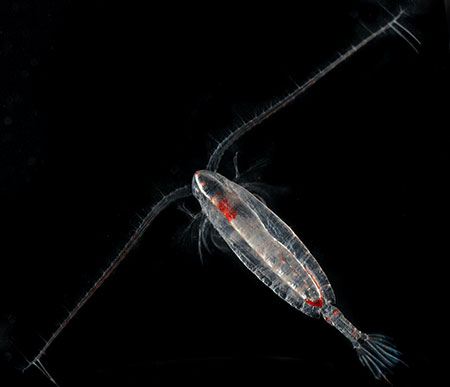Oceans cover three quarters of the Earth’s surface. The temperature, chemistry, currents, and life of the world’s oceans play a crucial role in making the Earth habitable for humankind. This is how the UN describes the function of the oceans under the 17 Goals to Transform Our World for global sustainable development, also known as the Sustainable Development Goals. It is also stated under this goal that oceans absorb about 30 per cent of carbon dioxide produced by humans, buffering the impacts of global warming.
“The sea plays a colossal role in the regulation of carbon dioxide in the atmosphere. There is a huge concentration of organic carbon in the oceans in the form af animals, plants, and dissolved organic matter,” says Professor Thomas Kiørboe, Head of Centre for Ocean Life at DTU Aqua.
Together with his colleagues, he is particularly interested in the role of the sea in the carbon cycle which—among other effects—means that CO2 is absorbed and stored in the oceans for hundreds, why thousands, of years. Global warming means that the oceans are getting warmer. And how will this affect marine animals and plants, which are the main players in the CO2 absorption of the oceans?
Fish are swimming toward the poles
Changes are being observed. For example, it can be ascertained that the distribution of marine species is shifting, i.e. the fish swim toward the south and north, and we can therefore read about mackerel appearing at the coasts of Greenland and anchovies in the North Sea. But if we look at some of the smallest inhabitants in the sea—zooplankton—it is perhaps less well known that they have also begun to distribute themselves differently in the sea. These small animals are interesting, as they constitute an important component in the CO2 absorption of the oceans: They eat CO2-rich meals in the form of plant plankton or phytoplankton, secreting it again as excrement, which sinks towards the ocean floor.
In the colder regions, zooplankton such as copepods hibernate in the winter, when they lie at the ocean depths feeding on their CO2-containing fat deposits. They thus excrete the carbon dioxide far below sea level. The journey of zooplankton up and down in the sea and the accompanying transport of CO2 are an important component of the so-called biological pump.
Thomas Kiørboe’s team of researchers monitor the copepods and have access to 60 years of sea research data from England, which provides unique insight into how the large and fat copepods, which can absorb a lot of CO2, in the North Atlantic are increasingly joined by the leaner and less CO2-gobbling copepods from warmer climes.
“We can see large shifts in the ocean's ability to absorb CO2, which indicates that the organisms are changing their habitats. Their distribution is not stable. We cannot say why this is happening, nor do we currently know whether the total CO2 absorption in the sea is larger or smaller. But we’re working on being able to describe this,” says Thomas Kiørboe.

New way to describe the sea
But one thing is to follow the copepod and understand its function in the sea. How do you, in turn, approach a description of marine ecosystems and project them to a warmer planet when the sea consists of 200,000 currently identified species and possibly also contains up to millions of not yet identified species?
The answer lies in the art of simplification.
“Normally, researchers look at species when trying to describe marine ecosystems, among other systems. But if we are to describe all species in the oceans, we’ll never finish. Instead, we have developed a new method for describing the animals: We look at their traits, for example their size, how quickly they grow, and what they eat. A relatively limited number of traits are of interest in this context. This allows us to reduce the complexity significantly, and it enables us to describe the sea in a more manageable way,” explains Thomas Kiørboe about the method, which is known as ‘trait-based approach’ and which he—and his colleagues in Centre for Ocean Life—have spent the last five years developing.
The Professor explains that the ‘trait-based approach’ enables researchers to describe the role of ecosystems and their interaction with the Earth’s atmosphere and climate:
“The function of ecosystems is, in fact, a result of what the organisms in them can and do—rather than what name they have.”
Predictions on the way
Thomas Kiørboe has high ambitions for the next five years of research in Centre for Ocean Life, and expects that the team of researchers will then be able to estimate the effect of climate change on the ecosystems of the oceans.
“We’ll be able to predict how the oceans respond to climate change. We’ll have robust models that can predict how the biological pump will function in a warmer sea, and what this means to the ability of the oceans to absorb CO2. We’ll also be able to make some predictions about how significant production conditions in the sea will change. And whether the fish will become larger or smaller, increase or decrease in number, and in which areas.”

The ‘trait-based approach’ is a new method for describing marine ecosystems developed by researchers from Centre for Ocean Life.
The method describes how, in reality, the functionality and structure of the complex ecosystems are a result of the traits of marine organisms. Such traits include the size of the organisms, what they eat, and how quickly they grow.
In popular terms, it is less important whether the organism is a mackerel or a whale. Centre for Ocean Life will use the ‘trait-based approach’ to acquire deeper understanding of the oceans’ ecosystems and their function in relation to production of biomass, distribution of nutrients, and storage of CO
2—and to examine how ecosystems respond to climate change.